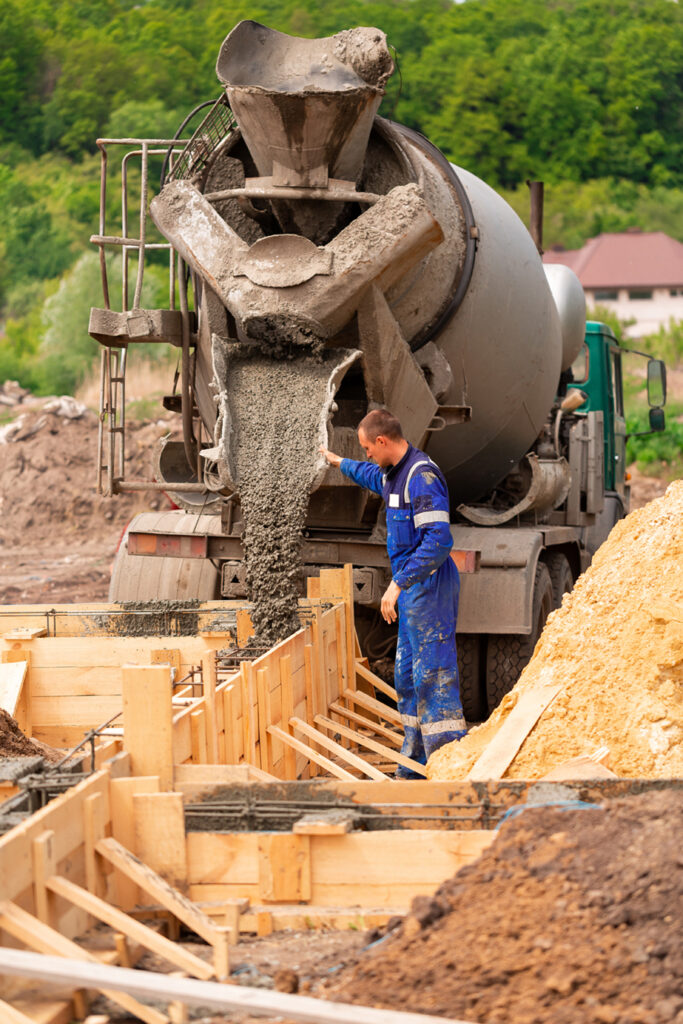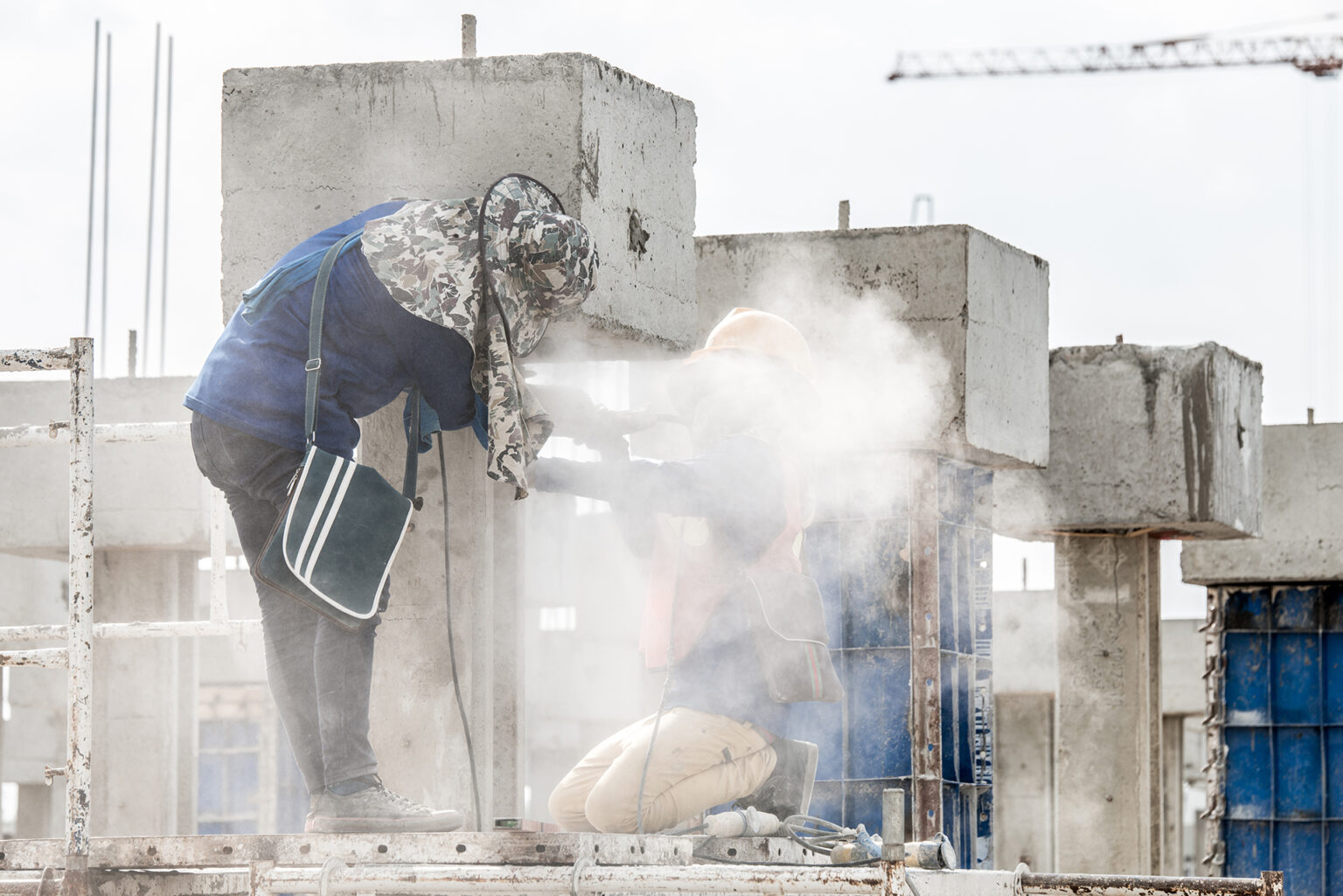
PHOTO BY LEN44IK / UNLIMPHOTOS
A forever favorite building material, concrete is responsible for about 8 percent of global carbon emissions. In Hawai‘i, recycling concrete and aggregate may help protect the state and preserve its resources — including its sand.
CAPTURING CONCRETE EMISSIONS
When talking about concrete, ‘carbon-capture’ refers to technology designed to mitigate the effects of climate change. According to Richard Malmgren, president of RCM Construction Corp., carbon-capture and storage (CCS) is an effort by companies to capture CO2 emitted as exhaust from the cement manufacturing process.
“Most emissions during cement manufacturing are due to chemical reactions, not fuel combustion,” Malmgren says. “One day, the point may be reached when more emissions are captured and stored than are generated in the production of cement. While potentially a contributor to a game-changing climate solution, CCS appears to be a long time away from becoming an industry standard.”
INJECTING CARBON TO HARVEST OIL
Malmgren says the Institute for Energy Economics and Financial Analysis (IEEFA), a private think tank funded by philanthropic organizations, has previously issued negative reports regarding CCS and carbon-capture utilization sequestering (CCUS).
Adds Malmgren, “While climate change needs to be addressed, it remains to be seen how effective/practical CCS will become as part of the solution.”
In its report, “The Carbon Capture Crux – Lessons Learned,” the IEEFA says, “CCS has been around for decades, mostly serving the oil industry through enhanced oil recovery (EOR). Around 80 percent to 90 percent of all captured carbon in the gas sector is used for EOR, which itself leads to more CO2 emissions. … That’s about three-quarters of the CO2 captured annually by multi-billion-dollar CCUS facilities globally – roughly 28 million tonnes (MT) out of 39MT total capture capacity – is then reinjected and sequestered in oil fields to push more oil out of the ground.”

Concrete is a perennial favorite among builders, yet it remains responsible for 8 percent of carbon emissions worldwide. PHOTO BY ANTPKR / UNLIMPHOTOS

Hawaiian Cement’s silos at Halawa Quarry store different types of cement and aggregate products. PHOTO COURTESY HAWAIIAN CEMENT
Spuds for StarCrete Settlements in Space
We don’t know if the masons who will eventually work on Mars (or the moon) are even born yet.
But scientists on Earth are forging ahead with formulas that could be the foundation for sprawling extraterrestrial structures for future settlements that will be out of this world.
Published in the March 2023 journal of Open Engineering was the study, “StarCrete: A Starch-Based Biocomposite for Off-World Construction,” by scientists Aled D. Roberts and Nigel S. Scrutton. They determined that using potato or corn starch as a binder for simulated extraterrestrial regolith would produce a high-strength biocomposite material, which they dubbed StarCrete – short for “starch concrete.”
Roberts and Scrutton tested albumin from human blood plasma and urea to combine with the regolith – but the thought of using human material is stacked with ethics challenges. The pair also experimented with maize (CoRncrete), rice, tapioca and wheat, and determined potato starch produced the best binder.
As water, and lots of it, is vital to the mixing of concrete, the scientists concluded that the dehydration and 4 percent rehydration of the starch would be optimal.
Growing the starches for food, and with the intent of producing a surplus to provide the gelatinous and viscous qualities necessary for construction – could be key to simplifying building and sustainability of extraterrestrial frontiers.
– Paula Bender
HAWAIʻI CAN BE SUSTAINABLE
Allan Evans, owner of Refrigerant Recycling Inc. says, “Concrete from demolition projects is a huge component in Hawai‘i’s waste stream. The good news is that it’s almost infinitely recyclable!”
He recalls a Kaka‘ako project that occurred a few years ago.
“We demolished a concrete building and re-used almost 100 percent [1,200 tons] of it for the same project. I can’t speak to whether or not it’s a money maker, but I do know that concrete recycling is absolutely necessary for the construction industry and the sustainability of our islands.”
CRUSHING IT
Hawaiian Cement is doing its part by grinding its own sand at Halawa Quarry with a machine from Metso, a company based in Finland. Metso is a global frontrunner in sustainable technologies, end-to-end solutions and services for the aggregates, minerals processing and metals refining industries. Its website, metso.com, features case studies from around the globe where its solutions have enjoyed success. Metso’s HRC8 unit was Hawaiian Cement’s solution to dealing with previously unusable concrete and aggregate waste.
Halawa Valley Operations Quarry produces various products, including ASTM C-33 (standards defining the size and quality of aggregate) concrete sand, which is used in the production of concrete mixes. This sand is made from a fractured volcanic basalt rock, starting at 24 inches for base material. The HRC8’s crushing circuit consists of a jaw crusher for primary crushing, a gyratory crusher for the secondary stage, a 300hp cone crusher for tertiary crushing and a VSI crusher for the quaternary crushing stage. The material is then washed and either packed or bulk loaded into trucks for delivery.

Jonathan Esperanza
CASE STUDY: HAWAIIAN CEMENT
Metso’s case study explores local contractor Hawaiian Cement and its conundrum of what to do with too much non-saleable inventory. While “Hawaiian Cement was able to manufacture some of the sand it needed, it also produced tons of unusable byproducts that were difficult to make useful because of the high moisture levels,” according to Metso.

Using concrete can be sustainable — when processed correctly, the building material is almost infinitely recyclable. PHOTO BY NOBILIOR / UNLIMPHOTOS
Discussions with partner Miller Machinery, which sells Metso products, led to the discovery of a new aggregate crushing technology that is specifically engineered to convert waste fractions into manufactured sand.
“The HRC8 crusher was put into operation to crush a byproduct of our current operations into a saleable product. Currently it is all in house materials and does somewhat reduce carbon emissions in our concrete production by reducing the amount of imported sand from British Columbia,” says Jonathan Esperanza, Hawaiian Cement general manager.
Discussions with partner Miller Machinery, which sells Metso products, led to the discovery of a new aggregate crushing technology that is specifically engineered to convert waste fractions into manufactured sand.
“The HRC8 crusher was put into operation to crush a byproduct of our current operations into a saleable product. Currently it is all in house materials and does somewhat reduce carbon emissions in our concrete production by reducing the amount of imported sand from British Columbia,” says Jonathan Esperanza, Hawaiian Cement general manager.
THE SCIENCE OF CONCRETE
Corralling CO2 from cement is the focus of studies around the world. A paper published on March 28, 2023, in the journal PNAS Nexus by MIT professors of civil and environmental engineering Admir Masic and Franz-Josef Ulm, MIT postdoc Damian Stefaniuk and doctoral student Marcin Hajduczek, and James Weaver from Harvard University’s Wyss Institute stated that “approximately half of the emissions associated with concrete production come from burning fossil fuels oil and natural gas, which are used to heat up a mix of limestone and clay that ultimately becomes the familiar gray powder known as ordinary Portland cement (OPC). … As the mineral mix is heated to temperatures above 1,400 degrees Celsius (2,552 degrees Fahrenheit), it undergoes a chemical transformation from calcium carbonate and clay to a mixture of clinker (primarily calcium silicates) and carbon dioxide, which escapes into the air.”
The scientists discovered that during concrete mixing and pouring before the material sets, the addition of sodium bicarbonate (baking soda) results in up to 15 percent of the total amount of carbon dioxide associated with cement production being mineralized — and potentially reducing its global carbon footprint.
The idea of early-stage concrete carbonation is not new. Companies have been exploring ways to facilitate carbon-dioxide uptake after concrete is cast. But MIT’s team highlights that the pre-curing capacity of concrete to sequester carbon dioxide is largely underestimated and underutilized.
“Our new discovery could further be combined with other recent innovations in the development of lower carbon-footprint concrete admixtures to provide much greener, and even carbon-negative construction materials for the built environment, turning concrete from being a problem to a part of a solution,” MIT’s Masic says, whose research was supported by the Concrete Sustainability Hub at MIT, sponsored by the Concrete Advancement Foundation and the Portland Cement Association.




